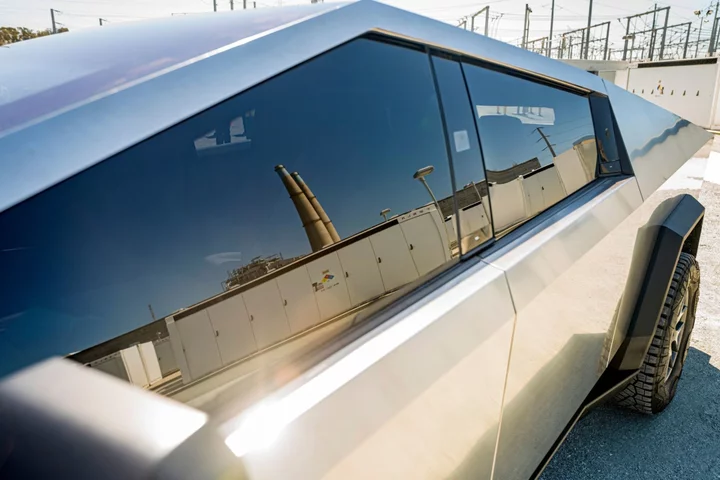When Tesla Inc. starts delivering Cybertrucks to customers next week, it will answer a question with major implications for the broader automotive industry: How much does the thing actually cost?
When Elon Musk first unveiled a prototype in 2019, he touted a mid-tier version with more than 300 miles of range that would be priced at just $49,900. At the time, that was only a few hundred dollars from the average price consumers were paying for a Ford F-150, America’s best-selling pickup. The competitive price was as much a surprise as the Cybertruck itself.
But that was four years and a pandemic ago. Tesla has scrubbed specifications from its Cybertruck order page, and Musk has repeatedly warned about cost and manufacturing challenges. Inflation has driven up the average amount paid for new pickups by 28%. Some reservation holders planning to attend the Nov. 30 launch party in Austin fear a dramatic repricing that could relegate the Cybertruck to a toy for the rich.
How much is too much?
If Tesla’s intent is for the dual-motor Cybertruck to more or less track the F-150, its price will end up rising to roughly $60,000. That could be the dividing line used to distinguish between whether this is a product actually built for utility or one that more so appeals to vanity.
The Cybertruck could land on either side of that $60,000 mark. Since the 2019 unveiling, battery prices have declined 12% and the price of the company’s long-range Model 3 sedan is down 5%. After Ford Motor Co. dropped the starting price of its electric F-150 Lightning to $49,995 in July, Musk wrote that it was “a good vehicle, just somewhat expensive.”
Three months later, Musk tempered his braggadocio. “We dug our own grave with Cybertruck,” he told analysts on an earnings call, referring to how difficult it was going to be to produce the pickup in high volume.
The other key Cybertruck spec will be battery range. This is especially important to truck owners, as hauling heavy loads at highway speeds can easily cut the rated range in half, and charging takes more time for bigger vehicles. A 300-mile range no longer seems as impressive after General Motors Co. debuted a Chevrolet Silverado EV work truck that’s able to go 450 miles per charge.
A good metric for comparing pickups is vehicle cost per mile of range. A luxury adventure truck like the Rivian R1T can get away with a higher cost per mile of range, but Tesla has higher-volume ambitions for the Cybertruck. The company has said it will have the capacity to make 250,000 Cybertrucks a year, which is more than ten times the early annual sales of the Rivian R1T and Ford F-150 Lightning. Selling that many Cybertrucks some day will require class-leading cost-per-mile value that can appeal to wide swathes of the truck market.
At the 2019 unveiling, Tesla promised three versions of the Cybertruck. At the high end was a tri-motor version with more than 500 miles of range for $69,900. There was also a base rear-wheel-drive model with 250 miles for $39,900, a version that’s unlikely to be available at launch, if ever. Tesla only registered 2024 vehicle identification numbers for two- and three-motor variants, and government filings refer to the dual-motor version as Standard and the tri-motor as Performance models.
A one-size-fits-most strategy
Part of Tesla’s challenge is its streamlined manufacturing strategy. Car giants including GM and Ford each offer hundreds of different sub-variants and trim packages to match any customer profile. In contrast, Tesla makes just four models — the 3, Y, S and X — each with a few basic options for customization, such as wheel size, color and battery performance. The idea is that the savings from streamlined manufacturing will outweigh the lack of options.
This one-size-fits-most approach could prove problematic for trucks. The needs of a construction worker, suburban football dad, rancher and outdoor adventurer don’t always overlap. That’s why most truck brands offer a multitude of choices: stripped-down work trucks that start around $40,000, six-wheeled freight haulers with extended beds, and six-figure rigs with luxurious cabins offering back massagers and quilted leather seats.
The Cybertruck will require a very compelling price — similar or better than the $50,000 starting point for the F-150 Lightning — to have a chance with traditional pickup buyers, says Jessica Caldwell, head of insights for Edmunds. Tesla’s first challenge will be to prove that the Cybertruck has the right functionality, then to convince customers to overlook the jarring design.
“This is going to be the toughest vehicle for Tesla to launch,” Caldwell said. “It’s going to sell really well initially because it does really resonate with some buyers, but not the mass market. That’s where the problem is.”
The one market segment that the Cybertruck seems to have a lock on is people who already own a Tesla. Early this year, Bloomberg surveyed 3,500 Tesla owners who were in the market for a new vehicle in the next two years. Among those shoppers — many of whom have never owned a pickup before — 37% were considering a Cybertruck.
When the Cybertruck was unveiled at an apocalypse-themed party in 2019, it wasn’t the lasers or smoke or controlled bursts of fire that got the crowd of Tesla superfans hollering. Nor was it the vehicle’s shocking geometry, sledge hammer-resistant doors or not-so-shatterproof windows. The event’s climactic moment was when a few simple price and range figures flashed in fine red print above the stage.
Since then, more than a million people plunked down $100 to reserve a place in line to buy a Cybertruck, Musk said on Tesla’s earnings call last month. That should be plenty to sustain several years of sales.
What follows will depend on the fine print coming at the end of this month.
Read More on Tesla:
- Backlash Spreads Over Musk’s Endorsement of Antisemitic Post
- Cybertruck Will Test America’s Great Political Divide
- Tesla's Year of Price Cuts Exposes Crisis for Legacy Auto
- Americans Insist on 300 Miles of EV Range. They’re Right
- American Cars Are Developing a Serious Weight Problem
- Tesla Owners Have Soured on Musk — But Not His Cars









